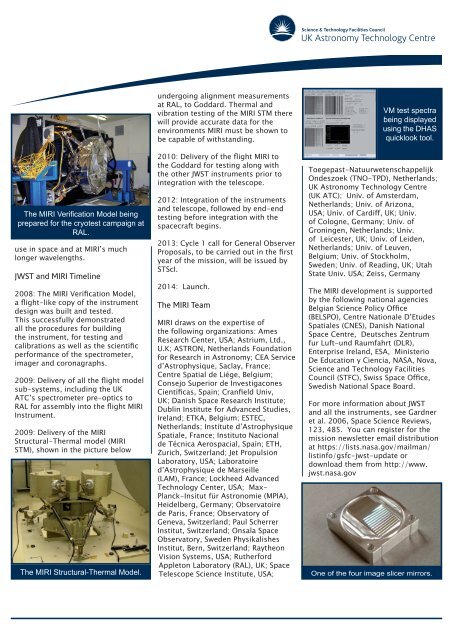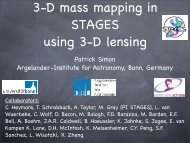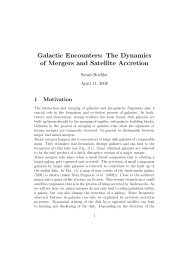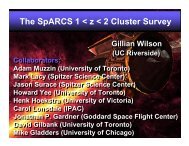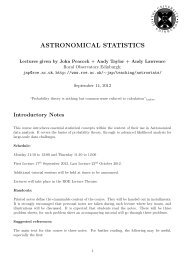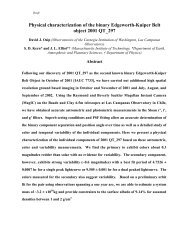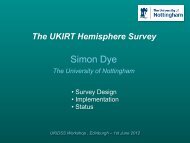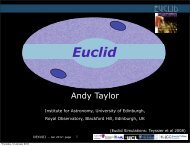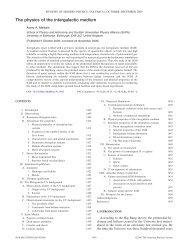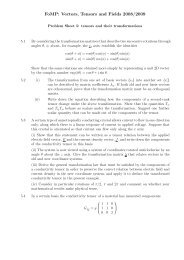MIRI for the James Webb Space Telescope - STFC
MIRI for the James Webb Space Telescope - STFC
MIRI for the James Webb Space Telescope - STFC
You also want an ePaper? Increase the reach of your titles
YUMPU automatically turns print PDFs into web optimized ePapers that Google loves.
The <strong>MIRI</strong> Verification Model being<br />
prepared <strong>for</strong> <strong>the</strong> cryotest campaign at<br />
RAL.<br />
use in space and at <strong>MIRI</strong>’s much<br />
longer wavelengths.<br />
JWST and <strong>MIRI</strong> Timeline<br />
2008: The <strong>MIRI</strong> Verification Model,<br />
a flight-like copy of <strong>the</strong> instrument<br />
design was built and tested.<br />
This successfully demonstrated<br />
all <strong>the</strong> procedures <strong>for</strong> building<br />
<strong>the</strong> instrument, <strong>for</strong> testing and<br />
calibrations as well as <strong>the</strong> scientific<br />
per<strong>for</strong>mance of <strong>the</strong> spectrometer,<br />
imager and coronagraphs.<br />
2009: Delivery of all <strong>the</strong> flight model<br />
sub-systems, including <strong>the</strong> UK<br />
ATC’s spectrometer pre-optics to<br />
RAL <strong>for</strong> assembly into <strong>the</strong> flight <strong>MIRI</strong><br />
Instrument.<br />
2009: Delivery of <strong>the</strong> <strong>MIRI</strong><br />
Structural-Thermal model (<strong>MIRI</strong><br />
STM), shown in <strong>the</strong> picture below<br />
The <strong>MIRI</strong> Structural-Thermal Model.<br />
undergoing alignment measurements<br />
at RAL, to Goddard. Thermal and<br />
vibration testing of <strong>the</strong> <strong>MIRI</strong> STM <strong>the</strong>re<br />
will provide accurate data <strong>for</strong> <strong>the</strong><br />
environments <strong>MIRI</strong> must be shown to<br />
be capable of withstanding.<br />
2010: Delivery of <strong>the</strong> flight <strong>MIRI</strong> to<br />
<strong>the</strong> Goddard <strong>for</strong> testing along with<br />
<strong>the</strong> o<strong>the</strong>r JWST instruments prior to<br />
integration with <strong>the</strong> telescope.<br />
2012: Integration of <strong>the</strong> instruments<br />
and telescope, followed by end-end<br />
testing be<strong>for</strong>e integration with <strong>the</strong><br />
spacecraft begins.<br />
2013: Cycle 1 call <strong>for</strong> General Observer<br />
Proposals, to be carried out in <strong>the</strong> first<br />
year of <strong>the</strong> mission, will be issued by<br />
STScI.<br />
2014: Launch.<br />
The <strong>MIRI</strong> Team<br />
<strong>MIRI</strong> draws on <strong>the</strong> expertise of<br />
<strong>the</strong> following organizations: Ames<br />
Research Center, USA; Astrium, Ltd.,<br />
U.K; ASTRON, Ne<strong>the</strong>rlands Foundation<br />
<strong>for</strong> Research in Astronomy; CEA Service<br />
d’Astrophysique, Saclay, France;<br />
Centre Spatial de Liége, Belgium;<br />
Consejo Superior de Investigacones<br />
Científicas, Spain; Cranfield Univ,<br />
UK; Danish <strong>Space</strong> Research Institute;<br />
Dublin Institute <strong>for</strong> Advanced Studies,<br />
Ireland; ETKA, Belgium; ESTEC,<br />
Ne<strong>the</strong>rlands; Institute d’Astrophysique<br />
Spatiale, France; Instituto Nacional<br />
de Técnica Aerospacial, Spain; ETH,<br />
Zurich, Switzerland; Jet Propulsion<br />
Laboratory, USA; Laboratoire<br />
d’Astrophysique de Marseille<br />
(LAM), France; Lockheed Advanced<br />
Technology Center, USA; Max-<br />
Planck-Insitut für Astronomie (MPIA),<br />
Heidelberg, Germany; Observatoire<br />
de Paris, France; Observatory of<br />
Geneva, Switzerland; Paul Scherrer<br />
Institut, Switzerland; Onsala <strong>Space</strong><br />
Observatory, Sweden Physikalishes<br />
Institut, Bern, Switzerland; Ray<strong>the</strong>on<br />
Vision Systems, USA; Ru<strong>the</strong>r<strong>for</strong>d<br />
Appleton Laboratory (RAL), UK; <strong>Space</strong><br />
<strong>Telescope</strong> Science Institute, USA;<br />
VM test spectra<br />
being displayed<br />
using <strong>the</strong> DHAS<br />
quicklook tool.<br />
Toegepast-Natuurwetenschappelijk<br />
Ondeszoek (TNO-TPD), Ne<strong>the</strong>rlands;<br />
UK Astronomy Technology Centre<br />
(UK ATC); Univ. of Amsterdam,<br />
Ne<strong>the</strong>rlands; Univ. of Arizona,<br />
USA; Univ. of Cardiff, UK; Univ.<br />
of Cologne, Germany; Univ. of<br />
Groningen, Ne<strong>the</strong>rlands; Univ.<br />
of Leicester, UK; Univ. of Leiden,<br />
Ne<strong>the</strong>rlands; Univ. of Leuven,<br />
Belgium; Univ. of Stockholm,<br />
Sweden; Univ. of Reading, UK; Utah<br />
State Univ. USA; Zeiss, Germany<br />
The <strong>MIRI</strong> development is supported<br />
by <strong>the</strong> following national agencies<br />
Belgian Science Policy Office<br />
(BELSPO), Centre Nationale D’Etudes<br />
Spatiales (CNES), Danish National<br />
<strong>Space</strong> Centre, Deutsches Zentrum<br />
fur Luft-und Raumfahrt (DLR),<br />
Enterprise Ireland, ESA, Ministerio<br />
De Education y Ciencia, NASA, Nova,<br />
Science and Technology Facilities<br />
Council (<strong>STFC</strong>), Swiss <strong>Space</strong> Office,<br />
Swedish National <strong>Space</strong> Board.<br />
For more in<strong>for</strong>mation about JWST<br />
and all <strong>the</strong> instruments, see Gardner<br />
et al. 2006, <strong>Space</strong> Science Reviews,<br />
123, 485. You can register <strong>for</strong> <strong>the</strong><br />
mission newsletter email distribution<br />
at https://lists.nasa.gov/mailman/<br />
listinfo/gsfc-jwst-update or<br />
download <strong>the</strong>m from http://www.<br />
jwst.nasa.gov<br />
One of <strong>the</strong> four image slicer mirrors.


